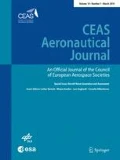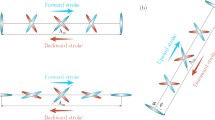Abstract
Many unconventional configurations for future aircraft, such as aircraft with very high aspect ratio wings or blended wing bodies, suffer from adverse flying characteristics for crosswind operations. Although the reasons for such undesirable behavior are different, coming from either tight geometric limitations, such as small bank angle allowances close to ground, or unfavorable flying qualities in the lateral motion, the consequences are challenging characteristics for take-off or landing under crosswind. In the presented study, a crosswind landing assistance system that makes use of a steerable main landing gear was designed and demonstrated in simulator trials. With such a system, the so-called de-crab maneuver is obsolete and the aircraft can touch down in crabbed motion. During roll-out on ground, the de-crab is performed automatically and the aircraft is kept on the runway centerline. A special concept for manual steering during this automatic de-crab on ground is introduced in the paper. The system is demonstrated in an A320 full-flight simulator with airline pilots, showing a good performance of the system and satisfactory pilot acceptance. The simulation results also show that the side forces acting on the landing gears could be reduced significantly with steerable main landing gears. This raises the hope that with such a system, the landing gear could possibly be designed lighter, saving at least some of the additional weight and cost for the necessary steering actuators of the main landing gear.

















Similar content being viewed by others
Abbreviations
- AFS:
-
Auto-flight system
- ATRA:
-
Advanced technologies research aircraft
- AVES:
-
Air vehicle simulator
- DLR:
-
German aerospace center
- EGT:
-
Exhaust gas temperature
- EPR:
-
Engine pressure ratio
- FCS:
-
Flight control system
- FHS:
-
Flying helicopter simulator
- FMS:
-
Flight management system
- GS:
-
Ground speed
- HTP:
-
Horizontal tail plane
- IAS:
-
Indicated airspeed
- ILS:
-
Instrument landing system
- METAR:
-
Meteorological aerodrome report
- NASA:
-
National aeronautics and space administration
- SFB:
-
Sonderforschungsbereich (collaborative research center)
- STOL:
-
Short take-off and landing
- Fx, Fy, Fz :
-
Longitudinal, lateral, and vertical component of the landing gear force (N)
- H :
-
Altitude (ft)
- k p :
-
Gain for proportional controller (−)
- ny, nz :
-
Lateral and vertical load factor (−)
- p tire :
-
Tire pressure (N/m2)
- T Track :
-
Time constant (s)
- u, v :
-
Longitudinal and lateral velocity component of tires (m/s)/(kts)
- V :
-
Air speed (m/s)/(kts)
- V Ground :
-
Ground speed (m/s)/(kts)
- XTE RWY :
-
Cross-track error on the runway (m)
- δ brake :
-
Proportion of braking applied (−)
- \( \eta_{\text{NG}} \) :
-
Nose gear steering angle (°)
- \( \eta_{\text{MG}} \) :
-
Main gear steering angle (°)
- \( \mu_{\text{s}} \) :
-
Side-friction coefficient (−)
- \( \mu_{\text{b}} \) :
-
Brake-friction coefficient (−)
- \( \mu_{\text{r}} \) :
-
Roll-friction coefficient (−)
- Ψ :
-
Aircraft heading (°)
- Ψ RWY :
-
Runway heading (°)
- ΔΨcrab :
-
Crab angle (°)
- τ :
-
Skid angle (°)
- \( \chi \) :
-
Track angle (°)
- \( \Delta \chi_{\text{chase}} \) :
-
Chase angle (°)
- \( \chi_{\text{CMD}} \) :
-
Commanded track angle (°)
References
Torenbeek, E.: Advanced Aircraft Design. Wiley, Chichester (2013)
Lee, J.J., et al.: Historical and future trends in aircraft performance, cost, and emissions. Annu. Rev. Energy Environ. 26, 167–200 (2001)
Bows, A.: Aviation and climate change: confronting the challenge. Aeronaut. J. 114(1158), 459–468 (2010)
Bradley, M.K., Droney, C.K.: Subsonic ultra green aircraft research: phase i final report, NASA/CR-2011-216847 (2011)
Hasan, Y.J., et al.: Handling qualities assessment of a blended wing body configuration under uncertainty considerations, German Aerospace Congress, Munich, Germany, 5–7 September 2017 (2017)
Liebeck, R.H.: Design of the blended wing body subsonic transport. J. Aircr. 41(1), 10–25 (2004)
Kauth, F., et al.: Progress in efficient active high-lift. In: AIAA-2017-3559, 35th AIAA Applied Aerodynamics Conference, 5–9 June 2017 (2017)
Campbell, J.P.: Status of V/STOL research and development in the United States. J. Aircr. 1(3), 97–106 (1964)
Quigley, H.C., Innis, R.C.: Handling qualities and operational problems of a large four-propeller STOL transport airplane, NASA TN D-1647 (1963)
Diekmann, J.H.: Flight mechanical challenges of STOL aircraft using active high-lift. In: AIAA-2017-3561, 35th AIAA Applied Aerodynamics Conference, 5–9 June 2017 (2017)
Flight Safety Digest, Approach and Landing Accident Reduction, Briefing Note 8.7, Crosswind Landings, Flight Safety Foundation (2000)
N.N., A320 FCOM Bulletin, No 21, Crosswind Landing Techniques, September 1992 (1992)
van Es, G.W.H., van der Geest, P.J., Nieuwpoort, T.M.H.: Safety aspects of aircraft operations in crosswind, Nationaal Lucht- en Ruimtevaartlaboratorium, NLR-TP-2001-217, May 2001 (2001)
Vechtel, D., Meissner, U.M., Hahn, K.-U.: On the use of a steerable main landing gear for crosswind landing assistance. CEAS Aeronaut. J. 5, 293–303 (2014). https://doi.org/10.1007/s13272-014-0107-2
Loudenslager, O.W.: Cross-Wind Airplane Landing Gear, US Patent US2504077, 11 April 1950 (1950)
N.N., Aircraft Specification No. A-790, Cessna 190/195, Federal Aviation Administration FAA, Department of Transportation, Revision 36, 31 March 2003 (2003)
The Boeing Company, B-52H Flight manual, T-O. 1B-52H-1, Change 22, 1 June 2006 (2006)
Rawdon, B.K., Zachary, C.H.: Method, system, and computer program product for controlling maneuverable wheels on a vehicle, US Patent US6,722,610B1, 20 April 2004 (2004)
Hahn, K.-U., Meissner, U.M.: Control device for aircraft, US Patent US 2012/0305704 A1, 6 December 2012 (2012)
N.N., A320 Flight Crew Operating Manual Part 3 Flight Operations, 01 June 2009 (2009)
Raab, C.: Flugdynamisches simulationsmodell A320-ATRA—Validierungsversuche und Bewertung der Modellgüte (English: Flight Dynamics Simulation Model A320 ATRA – Validation Tests and Evaluation of the Model Accuracy), DLR internal report, IB 111-2012/43 (2012)
Fischenberg, D.: A validated dynamic simulation model for VFW-614 ground handling, DLR internal report, IB 111-98/33 (1998)
Barnes, A.G., Jager, T.Y.: Enhancement of aircraft ground handling simulation capability, AGARDograph No. 333 (1998)
N.N., PEP Performance Programs Manual, Airbus Industries
Duda, H., Gerlach, T.: Design of the DLR AVES research flight simulator. In: AIAA-2013-4737, AIAA Modeling and Simulation Technologies Conference, Boston, USA, 19–22 August 2013 (2013). https://doi.org/10.2514/6.2013-4737
N.N., Joint Aviation Requirements, JAR-STD 1A Aeroplane Flight Simulators. JAA Joint Aviation Authorities (1999)
N. N., U.S. Military Handbook MIL-HDBK-1797, 19 December 1997 (1997)
Dryden, H.L.: A review of the statistical theory of turbulence. Q. Appl. Math. 1(1), 7–42 (1943)
Acknowledgements
This work was supported in part by funding from the Horizon 2020 Framework Programme (Grant No. 640597).
Author information
Authors and Affiliations
Corresponding author
Additional information
Publisher's Note
Springer Nature remains neutral with regard to jurisdictional claims in published maps and institutional affiliations.
Rights and permissions
About this article
Cite this article
Vechtel, D. How future aircraft can benefit from a steerable main landing gear for crosswind operations. CEAS Aeronaut J 11, 417–429 (2020). https://doi.org/10.1007/s13272-019-00410-4
Received:
Revised:
Accepted:
Published:
Issue Date:
DOI: https://doi.org/10.1007/s13272-019-00410-4




